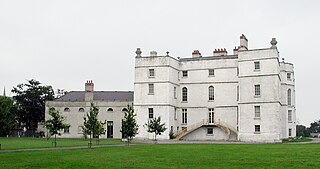In English common law, fee tail or entail, or tailzie in Scots law, is a form of trust, established by deed or settlement, that restricts the sale or inheritance of an estate in real property and prevents that property from being sold, devised by will, or otherwise alienated by the tenant-in-possession, and instead causes it to pass automatically, by operation of law, to an heir determined by the settlement deed. The terms fee tail and tailzie are from Medieval Latin feodum talliatum, which means "cut(-short) fee". Fee tail deeds are in contrast to "fee simple" deeds, possessors of which have an unrestricted title to the property, and are empowered to bequeath or dispose of it as they wish. Equivalent legal concepts exist or formerly existed in many other European countries and elsewhere; in Scots law tailzie was codified in an Act of 1685 which in 1896 was given a short title as an Entail Act.

The parishes of Jamaica are the main units of local government in Jamaica. They were created following the English Invasion of Jamaica in 1655. This administrative structure for the Colony of Jamaica developed slowly. However, since 1 May 1867, Jamaica has been divided into the current fourteen parishes. These were retained after independence in 1962. They are grouped into three historic counties, which no longer have any administrative relevance. Every parish has a coast; none are landlocked.

Rathfarnham Castle is a 16th-century fortified house in Rathfarnham, South Dublin, Ireland. Originally a semi-fortified and battlemented structure it underwent extensive alterations in the 18th century. It is in State care, has been restored and is open to the public.
Potosi is a former sugar estate in Trelawny, Jamaica. It was named after a fabled Bolivian silver mine.

Saint Andrew is a parish, situated in the southeast of Jamaica in the county of Surrey. It lies north, west and east of Kingston, and stretches into the Blue Mountains. As of the 2011 census, it had a population of 573,369, the highest of any of the parishes in Jamaica.
Charles Augustus Ellis, 6th Baron Howard de Walden and 2nd Baron Seaford, was a British diplomat and politician.
Mavis Bank is a rural coffee farming community approximately 10 miles (16 km) north east of Kingston, Jamaica in east rural St. Andrew in the Blue Mountains, close to the border of Portland.

East Allington is a village and civil parish in the South Hams district of Devon, England, three miles (5 km) south of Halwell and just off the A381 road. It lies about three miles (5 km) from Kingsbridge and about ten miles (16 km) from Totnes. The coast at Slapton Sands is about five miles (8 km) to the south-east. Also in the parish is the hamlet of The Mounts, about one mile (1.6 km) away.
Sir Nicholas Lawes was a British judge and colonial administrator who served as the governor of Jamaica from 1718 to 1722.

The Speaker's House is a museum located in Trappe, in Montgomery County, Pennsylvania that preserves the home of Frederick Muhlenberg, the First and Third Speaker of the United States House of Representatives. The house was built in 1763, bought by Muhlenberg in 1781, and occupied by his family until 1791.

Louis Celeste Lecesne, also known as Lewis Celeste Lecesne, was an anti-slavery activist from the Caribbean islands.
Slebech was a community in Pembrokeshire, Wales, which is now part of the combined community of Uzmaston and Boulston and Slebech, a sparsely populated community on the northern shore of the Eastern River Cleddau. The community shares boundaries with the communities of Wiston and Llawhaden and mainly consists of farmland and woodland. Much of the community is within the Pembrokeshire Coast National Park and Picton Castle's stable block loft is an important breeding roost for the rare Greater Horseshoe Bat.

Golden Clouds was the name given by Ruth Bryan Owen, the first female US ambassador, to her house in Oracabessa, Jamaica. It is situated between Goldeneye, where Ian Fleming wrote many of the James Bond novels, and Noël Coward's Firefly Estate. The ocean front 12-bedroom estate is on 7 acres (2.8 ha) of manicured lawn and gardens with over 500 feet (150 m) of shoreline and its own private beach.

Annery was an historic estate in the parish of Monkleigh, North Devon.

Soughton Hall is a Grade II* listed country house hotel in Sychdyn, Flintshire, Wales. Notable guests that have stayed include Luciano Pavarotti, Michael Jackson and King Juan Carlos I of Spain. William John Bankes inherited Soughton Hall in the 1815.
Benjamin Winter Sr. was a real estate developer in New York City and founder of Winter Incorporated. Winter served as president of the American Federation of Polish Jews.

Hope Botanical Gardens, also known as the Royal Botanical Gardens, is a 200-acre (81 ha) park and gardens located in St Andrew, Jamaica.

Henry Dawkins II was a Jamaican plantation and slave owner and Member of the Parliament of Great Britain (MP).

Margaret Macpherson Grant was a Scottish heiress and philanthropist. Born in Aberlour parish to a local surgeon, she was educated in Hampshire, and was left an only child when her elder brother died in India in 1852. Two years later, she inherited a large fortune from her uncle, Alexander Grant, an Aberlour-born planter and merchant who had become rich in Jamaica.

Charles Nicholas Pallmer was an English politician, West Indies estate owner and a supporter of slavery. He twice served as a Member of Parliament (MP), with his later career overshadowed by high debts and bankruptcy.













